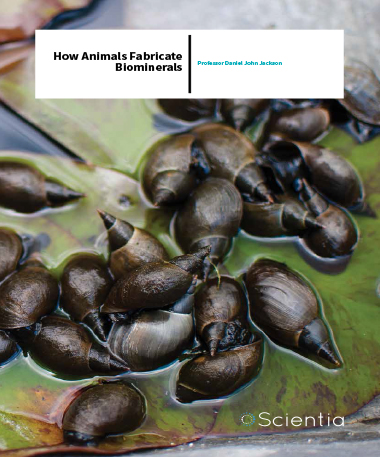Professor Daniel John Jackson – How Animals Fabricate Biominerals
Professor Daniel J. Jackson and his team at the University of Göttingen use snails and sponges as models to study how animals make biominerals, and to gain insight into how this ability first evolved. The cellular and molecular mechanisms that allow an animal to make a shell, a spicule, a tooth or a spine are incredibly complex and poorly understood in all but a few animals. However, the evolution of this ability, more than 540 million years ago, allowed early animals to precipitate calcium and other minerals in highly controlled and useful ways. This is likely to have provided key support for the rapid and widespread diversification of animal life in an unprecedented evolutionary event known as the Cambrian Explosion.
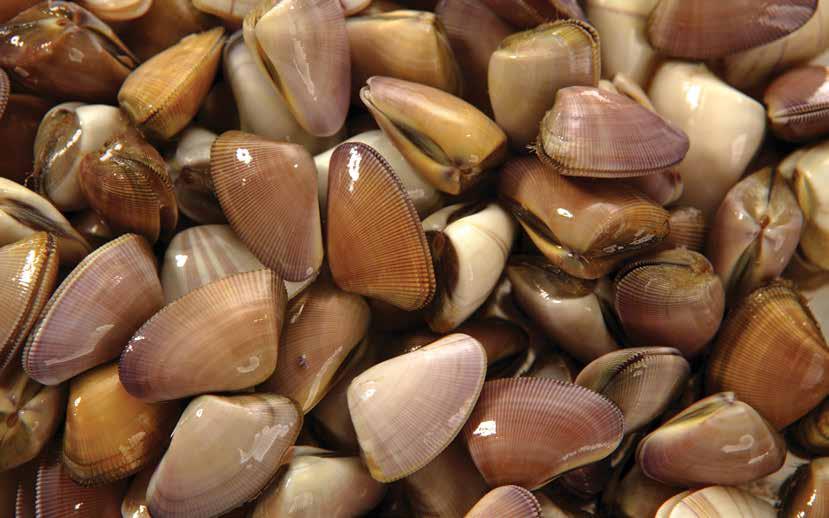
Biomineralisation
If you trace the phylogenetic tree of life back far enough, you will find that animals as complex as humans share a common ancestor with animals such as earthworms, corals, insects and all other animal life forms. Along this journey back in time a multitude of evolutionary events took place, some of which fundamentally influenced the diversity of animal morphologies that we see today. One of these key events was an innovation – the ability to ‘biomineralise’, or the ability of a living organism to synthesise mineralised body parts by combining organically derived molecules (for example proteins) with minerals available from the environment. Biomineralisation ranges from a sponge’s capacity to precipitate silica and a snail’s ability to make a calcified shell, to the complex organisation of the human skeleton. Understanding which genes and cellular processes regulate these processes in diverse animals, and whether they share any commonalties is one research theme that occupies Professor Jackson’s group.
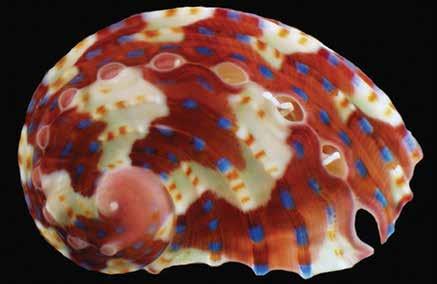 Biomineralisation occurs in representatives of all animal groups, and is responsible not only for the fabrication of endo- and exoskeletons and the structurally supportive roles they play, but also structures that play sensory, predatory and protective roles too. ‘At some point in time, more than 543 million years ago, a variety of environmental, biological and ecological factors acted together to pressure our soft-bodied animal ancestors to evolve the ability to make useful biominerals,’ Professor Jackson tells us. Then, very suddenly and synchronously (geologically speaking), there was a very rapid and sustained increase in the diversity of animal life forms. This particular period in the history of animal evolution has come to be known as the ‘Cambrian Explosion’. ‘Because of the close association between the evolutionary appearance of an ability to biomineralise, and the rapid and synchronous increase in the diversity of animal forms during the Cambrian, an understanding of the animal origins of biomineralisation would provide insight into how the diversity of animal life that we observe today came to be,’ says Professor Jackson.
Biomineralisation occurs in representatives of all animal groups, and is responsible not only for the fabrication of endo- and exoskeletons and the structurally supportive roles they play, but also structures that play sensory, predatory and protective roles too. ‘At some point in time, more than 543 million years ago, a variety of environmental, biological and ecological factors acted together to pressure our soft-bodied animal ancestors to evolve the ability to make useful biominerals,’ Professor Jackson tells us. Then, very suddenly and synchronously (geologically speaking), there was a very rapid and sustained increase in the diversity of animal life forms. This particular period in the history of animal evolution has come to be known as the ‘Cambrian Explosion’. ‘Because of the close association between the evolutionary appearance of an ability to biomineralise, and the rapid and synchronous increase in the diversity of animal forms during the Cambrian, an understanding of the animal origins of biomineralisation would provide insight into how the diversity of animal life that we observe today came to be,’ says Professor Jackson.
Advances in scientific technologies, such as whole genome sequencing, have better allowed scientists to study cellular and biological processes at a genetic level, and to make comparisons between animals in order to identify where changes and deep conservation have occurred. By first identifying which genes are directly involved in making a shell, a spicule or a spine, Professor Jackson and his colleagues hope to develop gene-specific in vivo functional assays that will allow them to further characterise the differences in biomineralisation programs operated by different species. This will allow them to understand, for example, how a mollusc makes its shell and how this ability first evolved.
‘A general theme of our work is to understand to what degree animals use the same genes and cellular processes to build their biominerals. This in turn should help us to understand some of the molecular details that accompanied the Cambrian Explosion and the generation of diverse complex animal life.’
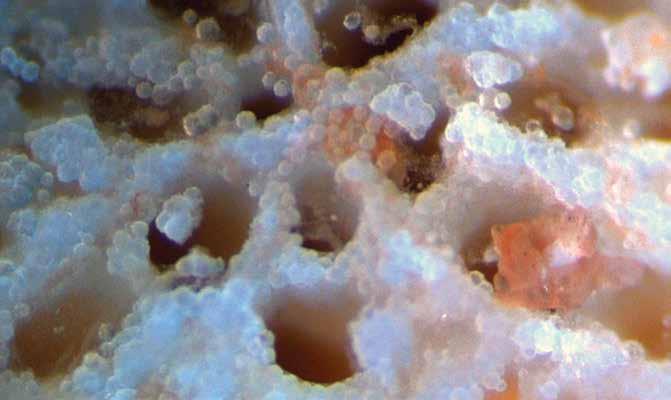
Accidental discoveries in the genetics of shell formation
Professor Jackson stumbled into the field of biomineralisation during the final phases of his PhD. He was initially seeking to identify some of the genes that coordinate the transformation of larval marine invertebrates into benthic adults. In his search, he identified two novel genes expressed in larvae preparing to metamorphose into the next phase of development. This is a critical and vulnerable stage during the development of many invertebrate species, and therefore has significant implications for global food production, particularly in countries where the primary protein source lies within the aquaculture industry. The specific model organism that Professor Jackson discovered these genes in was a commonly aquacultured mollusc, the abalone, and the genes of interest were highly expressed within the tissue that forms the shell. ‘The expression patterns of these two genes in the abalone larva were so beautiful, and so unique that they raised many interesting questions that weren’t on our radar at the time. I was immediately hooked and had to know more about what these shell-forming genes were doing, and what their origins were,’ he recalls.
Sponges and skeletal synthesis
One question that has long occupied the scientific community about the Cambrian Explosion is ‘why did it occur?’ Many hypotheses exist, including but not limited to the generation of novel genes and microRNAs, increasing ecological interactions between various previously isolated species, and changes in ocean water chemistry. However, none of these hypotheses answer the question of how and why so many individual organisms developed the ability to fabricate such a variety of mineralised structures. ‘Sponges are a very useful group of animals with which to address these kinds of questions,’ Professor Jackson explains. ‘If we can identify a cellular pathway, gene or process that is used by a sponge to biomineralise, and if a mollusc, or any other animal, also uses that same feature to build its skeleton, there’s a good chance that the last common ancestor of those two animals (which must have lived more than 543 million years ago) provided that feature to all of its descendants.’ Using this comparative approach,
Professor Jackson and his group recently used a sponge to demonstrate that the autophagy (‘self-eating’) pathway is utilised by at least one species of sponge to build its skeleton. Autophagy is not a sponge-specific or novel concept. It has proven involvement in both pathological and non-pathological processes, such as infection, cancer, arthritis, starvation and programmed cell death, and a Nobel Prize was awarded this year for its discovery. However, the connection between autophagy and biomineralisation is new. This idea could also be connected to the fact that early on in the Cambrian Explosion, seawater calcium concentrations rose to levels that would most likely have been dangerous to the cells of our distant animal ancestors. Professor Jackson theorises that some organisms may have developed biomineralisation strategies as a means to rid themselves of these toxic levels of calcium by employing the evolutionarily ancient autophagy pathway. Professor Jackson and his group also used the same sponge to identify a ‘calcification’ gene with a deep evolutionary history. The enzyme carbonic anhydrase, allows cells to combine carbon dioxide and water to produce bicarbonate and a proton, and is one of the most efficient enzymes known. This reaction, found ubiquitously in cellular metabolism and other processes, helps regulate pH, process metabolic wastes, fix carbon, and transports ions across membranes in all animals. Sponges are one of the earliest branching animals to secrete a calcium carbonate skeleton, and Professor Jackson has shown that sponges inherited a carbonic anhydrase gene from the last common ancestor of all animals, and that one version of this gene is still to this day employed by the sponge to build its skeleton. In another project, he demonstrated that another biomineralisation protein used by the same sponge was long ago horizontally transferred from a bacterium into the genome of the sponge. This work highlights the ancient and intimate association that exists between sponges and bacteria. It also draws a link back to the autophagy work, as it is this pathway that the sponge employs to degrade endobiotic bacteria. The degraded remains of these bacteria are then used as a template for biomineralisation by the host sponge.
‘While sponges are extremely informative because of their phylogenetic position on the animal tree of life, they are not the easiest model to work with on a day-to-day basis,’ says Professor Jackson. ‘They can be tricky to keep in an artificial environment (such as in the middle of Germany), and they don’t reproduce predictably, or on a scale that would support most of our research needs. For these practical reasons we turn to molluscs.’ Being the second most speciose phylum on the planet, the diversity of molluscan shells available for study is vast. They can also be used for many other fascinating research questions.
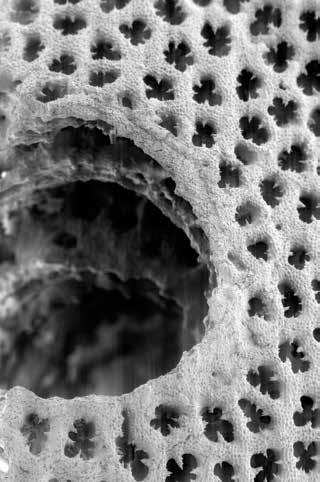 What causes asymmetry?
What causes asymmetry?
What causes most animals to develop an asymmetry about the left and right sides? While we like to think of ourselves as symmetrical about our mid-line, the reality is there are many differences between our right and left sides. For example, we carry our heart, spleen and pancreas on the left, while our brains display complex neurological asymmetries that we are only beginning to understand. What are the genes that control the process of establishing left-right asymmetry early in life, and are they the same genes used by all animals? A focused international collaboration involving Professor Jackson and led by Professor Angus Davison (The University of Nottingham, U.K.) identified a single mutation that causes snails to coil their shell in the opposite direction to that normally observed. Formin, a highly conserved cytoskeletal protein, may be largely responsible for determining leftright patterning in both molluscs and vertebrates, including humans. Using the pond snail as a model, the team discovered that a disabling mutation in the formin protein is associated with ‘symmetry breaking’ events in embryos of the pond snail. By administering a specific ‘antiformin’ treatment to normal snail embryos, chirality was reversed. The same treatment randomised chirality in developing frogs. This study highlights the value in using nonconventional model organisms and supports the notion that asymmetry is a highly conserved, ancient property shared by all complex animals.
Evo-devo and its relevance to an integrated understanding of biomineralisation
Evo-devo, or evolutionary developmental biology, interprets developmental processes within an evolutionary framework, and Professor Jackson emphasises that conducting his studies through this lens is critical to the advancement of his research within the field of biomineralisation. Because biomineralisation begins very early in life for most animals, the developmental programs that coordinate, regulate and initiate the deposition of mineralized structures hold a great deal of information for the evolutionary biologist. ‘While we know those first genes we discovered in abalone larvae are somehow involved in biomineralisation, we unfortunately still don’t know exactly what they’re doing,’ Professor Jackson explains. He and his colleagues intend to continue in the same direction with the hopes of harnessing the rapidly evolving molecular technologies available to the scientific community. ‘Exciting new technologies are now becoming available that should allow us to start revealing the functions of these novel genes in vivo,’ Professor Jackson tells us. The development and availability of new genome editing methods should allow researchers working with nonconventional model organisms to begin to interrogate and interpret the wealth of sequence data they have had access to for some years now. By establishing these new technologies in our model organisms, Professor Jackson’s team will continue to study and compare the complex genetic interactions and pathways responsible for the production of molluscan shells, with the aim of ultimately shedding some light on the molecular events that supported the evolution of all animal life.
Meet the researcher
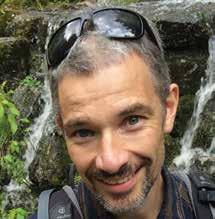
Professor Daniel John Jackson
Department of Geobiology
Goldschmidtstr. 3
University of Göttingen
Göttingen 37077, Germany
Daniel J. Jackson achieved his PhD in 2004 from the University of Queensland, Australia, for a thesis focused on developing applied and molecular approaches to improve the cultivation of the tropical abalone. From this work he became fascinated by the genetic mechanisms snails and oysters use to build their shells, and pursued postdoctoral research under this theme at the University of Queensland and then the University of Göttingen, Germany, prior to becoming a Junior and then Full Professor in the Department of Geobiology, University of Göttingen. He now teaches numerous graduate and undergraduate courses, has supervised over 20 students and postdoctoral researchers, and collaborates with evolutionary biologists worldwide to unveil the intricacies of how invertebrates biomineralise.
CONTACT
T: (+49) 551 39 14177
W: http://www.uni-goettingen.de/en/102705.html
FUNDING
Deutsche Forschungsgemeinschaft (DFG)
VolkswagenStiftung
REFERENCES
A Davison, GS McDowell, JM Holden, HF Johnson, GD Koutsovoulos, MM Liu, P Hulpiau, F Van Roy, CM Wade, R Banerjee, F Yang, S Chiba, JW Davey, DJ Jackson, M Levin & ML Blaxter, Formin is associated with left-right asymmetry in the pond snail and the frog, Current Biology, 2016, 26, 654–660.
DJ Jackson & BM Degnan, The importance of evo-devo to an integrated understanding of molluscan biomineralisation, Journal of Structural Biology, 2016.
K Mann, DJ Jackson, Characterization of the pigmented shell-forming proteome of the common grove snail Cepaea nemoralis, BMC Genomics, 2014, 15, 249.
DJ Jackson, L Macis, J Reitner and G Wörheide, A horizontal gene transfer supported the evolution of an early metazoan biomineralization strategy, BMC Evolutionary Biology, 2011, 11, 238.
DJ Jackson, L Macis, J Reitner, BM Degnan, G Wörheide G, Sponge paleogenomics reveals an ancient role for carbonic anhydrase in skeletogenesis, 2007, Science, 316, 1893.

